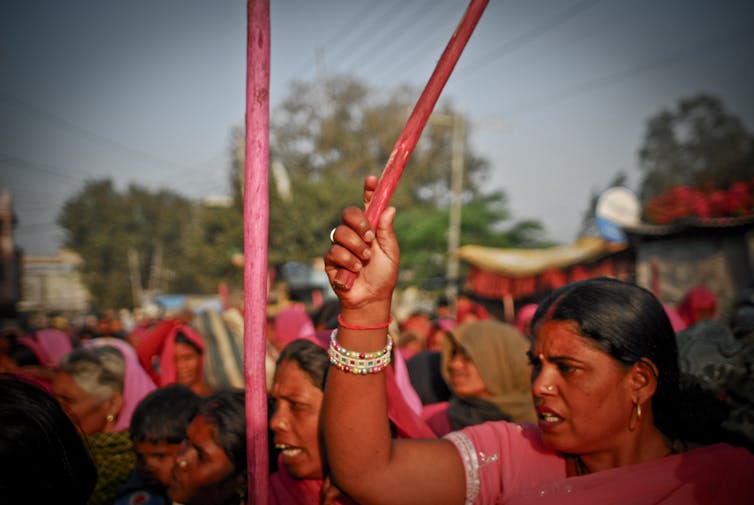The video for Hymn for the Weekend, Coldplay’s recent single, is full of colour. Purging India’s palette in a typically Western fashion, there’s a bright yellow temple, billowing orange fabric, dazzling Krishna blue. Pink powder (gulal) is everywhere, drifting between shots, caking the face of lead singer Chris Martin as he writhes in a boat that is itself coated in coloured dust.
Irrespective of innovation and the cultural appropriation zeitgeist, this music video is an aesthetically flimsy and embarrassingly awkward adoption of “Indiana” and the Hindu festival of Holi, at which coloured pigment is thrown to celebrate the start of spring. It smacks of orientalist fantasy, and as such caused much unease at the time of its release.
But Coldplay’s recent tokenistic mining of Indian iconography is part of a much broader trend. Coloured dust at Holi “festivals” is now seen all over the world, from English music festivals to corporate events. Coldplay are only the latest to hop on the bandwagon.
It is important to recognise that this cultural import has more significance than simple aesthetics, particularly because it overlooks the central importance of pigment in contemporary Indian politics. And missing the socio-cultural context of these colour festivities is particularly misguided given India’s mounting Hindu nationalism.
Party pods
Holi, which falls this year on March 24, has been secularised to the extent that even London corporates can get involved. One company, advertising their “purpose-built party pod”, invites workers to:
Leave the dull, grey City at the door, don your protective white suit, and step into the madness at the House of Holi, for thirty minutes of paint-pelting friends, family and colleagues, in a colourful powdered wonderland!
The branding of these events, such as those managed by Holi One, conjures up wild abandonment. This is a “colour riot”, a “colour run”, it is energetic and whimsical, “boisterous” and “cheeky”. The grinning PR machine certainly doesn’t choose to pick up on the fact that in many regions in India, public celebrations are curtailed due to what is contentiously termed “eve teasing”; a form of female sexual harassment.

Not only does this pastiche empty the festival’s latent sexism, it also ignores India’s broader relationship with colour: specifically, how political pigment is.
Colour has actually incited political riots. Between 1839 and 1860, blue became a battleground upon which colonial structures were unnerved, as indigo dyers and cultivators in Bengal mutinied due to their mistreatment and exploitation, leading the Lieutenant Governor, John Peter Grant, to conclude that this was not “an ordinary question concerning a particular blue dye”.
Today, colour remains a tool which can shift the political landscape. Contextualised by the Hindu division of days of the week into auspicious colours – Thursday is yellow, for example – pigment pervades daily routine. Clothing and food choices are frequently made according to this calendar.
And in the country with the lowest rate of adult literacy in the world (the most recent census statistics show 37% of the adult population is illiterate), colour is an accessible mode of communication. In fact, observing colour is regarded in a very different way to in the West. The theory of “rasa” holds that objects and colour are symbiotic with deep emotion and mental response, not dissimilar from the synaesthetic colour theories of Kandinsky et al.

Pigment politics
So in a country that is just under 80% Hindu, it’s little wonder that this popular symbolism has been adopted by political parties. Using colour in political campaigns is an instant way of gaining visibility and recognition on a meaningful level. The Gulabi Gang were momentary masters of this methodology. Operating across Uttah Pradesh from 2006 to 2014, the group used pink (gulabi) to engage potential members and provide an innocuous platform from which to spread their activism.
This colour became synonymous with the group. Supporters were committed, at a cost of approximately 250 rupees (£2.60), to wearing pink saris and carrying pink lathi (sticks). Courtesy of animated, congratulatory international press reportage, pink became seen as successfully facilitating female activism. Copy-cat movements, such Nisha Susan’s Chaddi (underwear) campaign, adopted the same colour, which rippled into Amul butter advertising.

And this legitimisation of politics through colour remains in the so-called “saffron revolution” adopted by Modi since 2014. Painting his energy revolution and broader policies with Hinduism’s most spiritual colour is astute. Removing past associations of the term with fuel protests in Myanmar in 2007, Modi is associating saffron with progressive politics and using it to shine a light on India’s uptake of renewable energy forms, including nuclear, solar, wind and biomass. (Although the recent nuclear leak in Gujarat, Delhi’s rise to the top of the polluted capital hall of fame, and the perpetual coal rush hopefully dims the force of this misplaced saffron vibrancy.)
While a life in black and white is dull, it is important to think critically about colour’s relationship with society. As Holi gains currency, consider that colour is not just for throwing. Both in India and globally, relationships are built and sustained through hues. As material and metaphor, colour politically and socially coheres society. And with the latest launch of perfumes by the socialist Samajwadi party it looks like scent could be the next political frontier. This again harnesses sense. Aligning smell with political icons such as the Taj Mahal and Lucknow’s Rumi Darwaza, let’s see if fragrance now diffuses through society in the ways that colour has and always will.

